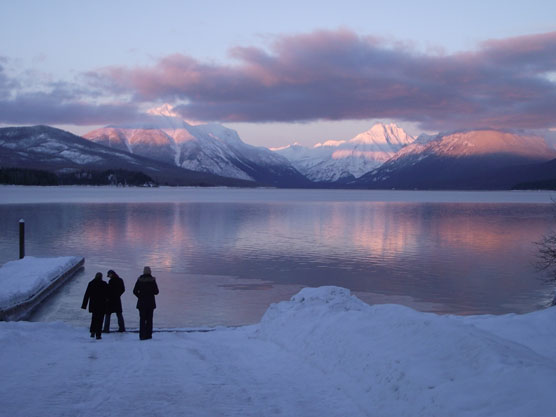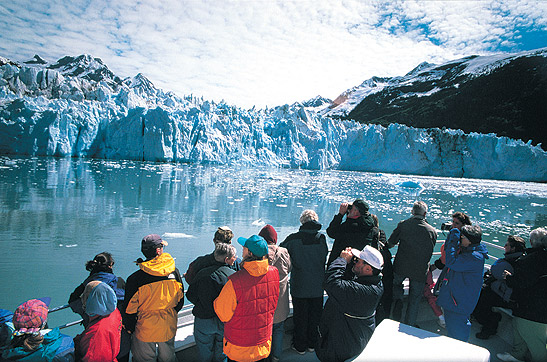1-Look at the links related to the Himalayas, Glacier National park and Antarctica.
Behaviour of Glaciers in the following areas:
I)Himalayas- Himalayas are the youngest and highest mountains of the world and have the largest concentration of glaciers outside the polar caps. In the Himalayas, glaciers happily advance in a healthy climate and retreat in response to a warmer climate. For instance they've seen the Chhota Shigri glacier change in length due to change in temperature and the snowfall pattern in the Himalayan region from 1962 to 2008 for 46 years.
 |
II) Glacier National Park- A warming climate is becoming popular in Glacier National Park. Between 1900 and 1979, the Glacier Park area experienced an average of 181 days every year when the temperature dipped below freezing. Between 1980 and 2005, warming had reduced the number of below-freezing days to 152. The region now experiences, on average, eight more days each year when temperature tops 90 degrees. This causes the glaciers to behave by shrinking in size because of the heat. Over the past decade, the national park warmed at twice the rate of the overall planet. Many of the park's small glaciers are gone entirely and others are shrinking quickly.
 |
III)Antarctica- Antarctica has a summer melting season and since records began, 50 years ago, mean annual temperatures have risen rapidly. Warming does continue especially in the summer and it causes glaciers to behave and respond by melting. There have been many losses and shrinkage of glaciers. The rate of warming in Antarctica is among the highest seen anywhere on Earth in recent times.
Impacts of Glacial Retreat:
I) Social Impacts:
-tourists wont go glacier tourist attractions because glaciers are disappearing
-people may be displaced because of the rising sea level and rising rivers (happened in Bangladesh)
- people's crops will be destroyed
-people's homes will be destroyed
 |
II) Environmental Impacts:
-can alter flow of downstream rivers
-can expand both land and marine habitats at the margins of glaciers
-can reduce pressure on the crust causing instability of existing faults potentially contributing to earthquakes.
-can cause natural disasters
 |
III) Economic Impacts:
-economic loss to tourism
-destruction of property will come at a heavy cost from the destruction of rising waters
-need money to help rebuild city from possible destruction
-relief and recovery costs from possible destruction
 |
Part B) Research the impact that glacial retreat will have on the tourism industry in areas that currently have glaciers. (think about Alaskan cruises, Banff, The swiss alps, etc)
Glaciers are an important tourist attraction for instance with the Alaskan cruises, Alaska, Banff, Swiss Alps, Glacier national park and many others. Hundreds of thousands of tourists visit Alaska's glaciers each year. As they shrink due to global warming and other reasons, many of them are becoming less available to tourists. They are retreating from visitor centres, retreating into shallow bays where cruise ships cannot follow them or no longer are calving into the ocean. Shrinking glaciers can lead to a reduction in glacier and cruise ship tourism resulting in a large economic hit. For example, in Montana's Iceberg Lake in Glacier National Park, they make approximately $3 billion dollars each year. Without the glaciers, the tourism industry would be destroyed. Tourists would stop coming, and they wouldn't be making any profit. It would be a significant economic disadvantage.
 |
Part C) Discuss the impact that retreating glaciers will/have already had on your country. If you have a country that does not have glaciers specifically in it think about general impacts as a result.
It is very rare for glaciers to be on the state of Hawaii. There have been a few cases but not many that is why I chose to discuss the general impacts of retreating glaciers. Retreating glaciers can cause sea level to rise by adding water to the ocean either in the form of melt water or calved-off icebergs. Rising sea level can negatively impact Hawaii by causing coastal erosion, flooding of low-lying areas and causing storms to occur . The melting of glaciers, could alter the flows of downstream rivers. It can also expand both land and marine habitats at the margins of glaciers. Glacier retreat can also lead to a series of natural hazards. As glaciers shrink, they can change and reduce pressure on the crust causing a decrease of stability of existing faults potentially contributing to earthquakes. These are some of the general impacts to a country or state from retreating glaciers.
 |
No comments:
Post a Comment